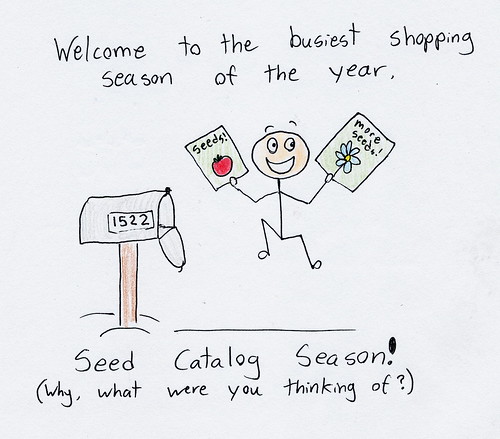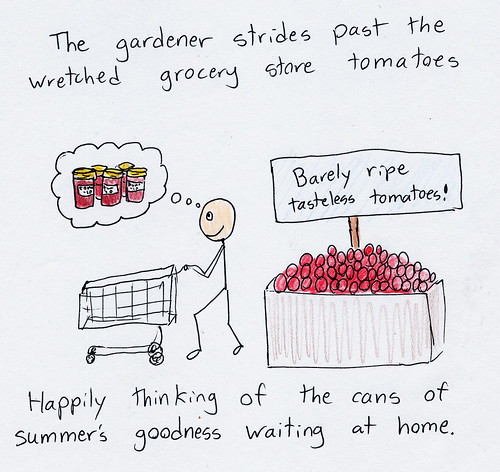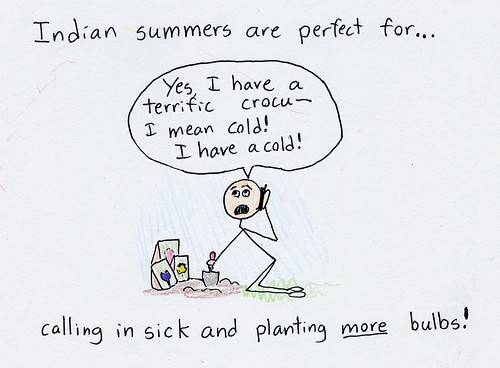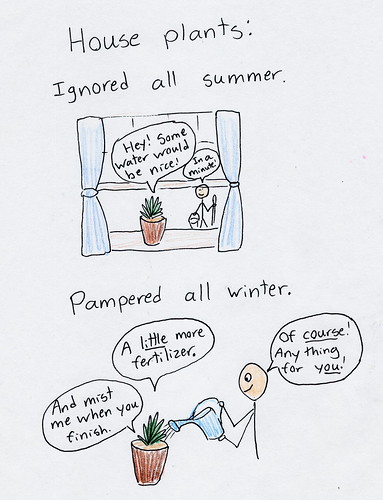It is official. Plant catalog season is underway! Time to make some tea, get a blanket, and do some serious dreaming about next year's garden. To celebrate, I'm writing this post, which is an annotated list of all my favorite, can't-live-without-'em catalogs. I thought about pretending that this was for the purposes of sharing good information with you, my readers, but in reality, that is just a ploy. I always worry that I'm missing out on great catalogs, so this is my chance to pick all your brains on the best sources I don't yet know about. So PLEASE, if you love a company that isn't on my list mention in it in the comments, or better yet, talk about them on your blog (if you have one) and leave a link to it here.
I should add that this list is almost all seed catalogs. I am a huge fan of buying seeds through the mail. Mail order plants are tiny, expensive, and generally very stressed by the whole shipping process. Mail order seeds, on the other hand, are cheap (critically important to a grad student like myself) and utterly unfazed by shipping. They also cross country lines easily, unlike growing plants, which means you can happily shop from around the world. Seeds also solve the great problem of balancing the collecting urge to have one of everything with the good design imperative to plant in drifts since a single packet of seed easily produces a dozen or more plants. In short, seeds are the best -- within reason, of course. Some things are a pain to germinate, or don't come true from seed, but for everything else, there are seeds.
Oh, and I should say: I've never gotten any sort of kick-back or blogger swag from any of these companies. I just love 'em.
So, with no further ado, my very favorite catalogs, in no particular order:
Seed Savers Exchange
An exciting, diverse range of very cool heirloom vegetables. Nonmembers can shop the catalog, members get access to the entire seed exchange. I finally joined up this year and can't WAIT to see all the amazing stuff I'm going to have access to.
Johnny's Selected Seeds
If you grow vegetables in the north, you've got to check out Johnny's. Their catalog is more informative than most gardening books, you can rely on their varieties to perform, and they do great breeding work. I go to other catalogs for crazy experiments. I go to Johnny's for solid varieties and information I can count on.
Pinetree Garden Seeds
I always order a lot from Pinetree because they've got a winning formula: Small seed packets, and very low prices. Who really needs 200 tomato seeds anyway? They have a very diverse selection of vegetables, many of them quite hard to find anywhere else. My only complaint is that their catalog is always horribly confusingly organized (why on earth aren't all the tomato varieties together in the same section?) but that is a minor quibble. Pinetree can't be beat when it comes to value for your money.
Territorial Seeds
I don't order much from Territorial, but I really like them. They do vegetables. Essentially they are a Johnny's for the Northwest, and since I don't live in the Northwest, their stuff is less applicable to me. But the catalog is a great, information packed read, and they always have a some quirky, cool things I want to try and can't find anywhere else.
Chiltern Seeds
Chiltern... love, love, love, adore this catalog. They're in the UK, but ship to the US without any fuss or bother, and
oh, what a catalog. Their focus is ornamentals, and what a selection it is... page after page after page of amazing things I've never heard of. The catalog is also a lot of fun to read with funny, silly descriptions. On the down side, Chiltern is very expensive, especially with the exchange rate, and since they are in England their descriptions of how hardy or easy to grow something is essentially mean nothing here in my climate. That being said, even very expensive seeds are incredibly cheap compared to buying plants at the nursery, so why not experiment? This catalog is a high point. I read it cover to cover several times every winter with google and stacks of reference books around me. Chiltern will give you a wildly interesting botanical education, and a LOT of plant lust to deal with.
Gardens North
Another insanely terrific seed company for rare and unusual ornamentals. The selection is at least as varied and fascinating as any of the British companies I recommend here, but they are in Canada which means that I can actually GROW all the cool stuff they have on offer. They don't publish a paper catalog, which is kind of sad, but the website is wonderful. It also changes frequently throughout the year, meaning I have to go check out what they are up to every few months... and order a few things.
B and T World Seeds
B and T does seeds of ornamentals. This isn't really a browse-able catalog, because there are essentially no descriptions, but the selection is mind-boggling. If there is a specific thing I'm looking for, and no one else has it, they usually do. Based in France, ships to the US effortlessly.
ebay
Who would have thunk? Like B and T, ebay is hard to browse, but recently I've discovered that the range of rare (and not so rare) seeds and plants you can pick up there is pretty surprising. Quality is, of course, hit or miss, but I've actually always had good experiences. I always check there when I want something specific and can't find it anywhere else.
McClure and Zimmerman
My personal favorite bulb sellers. The selection is good, the catalog is very pleasant reading, and service is great. My default source for fall and spring planted bulbs.
Old House Gardens
This is a new one for me this year -- which is shocking since they are right here in Michigan! They are bulb sellers, with a solid, interesting selection. They might just be rivaling McClure and Zimmerman for my business this year.
Rosy Dawn Gardens
I just surfed into this company the other day, but I'm super excited about it! I love a company that REALLY specializes. These people just do coleus. Lots and lots of uber-cool coleus, some of their own breeding. Now I feel like I can stop by their site and know I've got access to everything coleus have to offer.
Specialty Perennials
I hesitate to recommend this company, but since I end up ordering from them every year I feel I can hardly leave them out. They do seed for a wide range of hardy perennials. I like them because they have a great listing of rare and unusual stuff, and also seeds of things that you can usually only buy as plants (last year, for example, I got heuchera, bergenia, and astilbe seed from them) which is great for someone like me who is gardening on a tight budget. The downside is their customer service or, rather, the lack thereof. Place an order, and your credit card gets charged right away and then it can take literally
months for an order to get shipped. To add insult to injury, in the mean time they won't respond to e-mails or calls trying to find out what is going on. However, the seeds always do eventually arrive with fun free extras, prices are quite low, and the selection is good. So every year I bite my tongue, order early, and am patient.
Plant Delights Nursery
Does anyone NOT know this one? Just in case you don't, they sell a mind-boggling range of ornamental perennials. PDN is pricy, but also worth it. Like all really great nurseries, PDN focuses on their local climate, namely hot and humid North Carolina, so their selection is less applicable for me here in chilly Michigan, but I seem to end up ordering something from them every year. Whether you order anything or not, the catalog is a must read. Nobody writes a plant description quite like Tony Avent...
Annie's Annuals (and perennials)
If you've ever googled an unusual plant name, you've probably had Annie's Annuals pop up as a hit, complete with a lovely photograph and lots of good info. Annie's is a truly amazing nursery, with a stunning and eclectic array of both ornamentals and vegetables. Since they are in California and I'm in Michigan, a browse through their catalog leaves me with a severe case of zone envy more often than an actual list of plants to buy, but still, I wouldn't give up looking through for anything. Someday I'll build a greenhouse just so I can grow everything Annie sells.
Plant World Seeds
I just learned about this one last year, and oh MY. They are now rivaling Chiltern and Gardens North as my absolute favorite source of seed for ornamentals. Just typing their address into my browser sends a little shiver of joy down my spine. They're in England, so all the usual comments about climate and the expense due to the exchange rate, but what a catalog! What a selection! Plant World does a lot of their own breeding, so their catalog is full of hot-off-the-press, completely unique, new varieties. If nothing else, you've GOT to check out their selection of fragrant columbine. Now that I've grown them, I absolutely refuse to grow anything else. That is the sort of catalog this is: one that will change how you think about whole groups of plants.
Baker Creek
Rapidly becoming THE heirloom vegetable seed company, Baker Creek has a stunningly diverse, fascinating selection of varieties from around the world. Where so many companies take the "heirloom" concept only as far as the old standards like 'Brandywine' tomatoes, Baker Creek goes literally all over the world with things like a red-and-purple striped tomato from China or a watermelon from Iraq. The catalog for seriously crazy vegetable fun.
J.L. Hudson
This is perhaps the quirkiest seed catalog I've ever read. Vegetables, ornamentals, odd "ethnobotanicals", you name it. The selections are always intriguing (want to grow a bitter-but-edible wild relative of lettuce?) and I always have a great deal of fun reading it. Since they are seeds, experimentation is cheap, and experiment I always do.
A.M. Leonard
No plants here, but every tool, stake, or widget you could possibly want for your garden. Frustrated with my local garden center's vast selection of hideous garden sculpture and tiny selection of overpriced hand tools that break, I've shifted my gardening hardware needs 100% to AM Leonard. The quality is high with solid, dependable tools rather than gimicky gadgets, prices are low, and shipping is practically instantaneous.
Glasshouse Works
This is my source of choice for unusual house plants and tropical plants for the garden. Their list of varieties is long and incredibly diverse, but their website a giant confusing mess of links and images, and it can be quite difficult to find your way around (a friend who visited the nursery in person said it was just as confused and dis-orderly there). Once you do get to the list of plants, however, be prepared for some fun. The coleus go on for pages, as do the begonias (many from their own breeding program). Shipping can be very slow, as sometimes they have to root a cutting before they can send a plant to you, and I've gotten a few dreadfully pot-bound, overgrown things from them, but everything has been disease and pest free, and they always seem to throw in a few free plants with the order. When I ordered a few begonias this spring, they included three extra ones, along with a note saying they were nice varieties, and a little more reliable than the ones I had ordered. I'd love these people just for the wide selection, but that generous, personal touch really keeps me coming back.
Arrowhead Alpines
Despite the name, Arrowhead doesn't just do alpines -- they do just about any ornamental plant you can think of, and many you can't think of because you've not heard of them yet. They are one of the great specialty nurseries in the country, with an enormous sprawling catalog packed with delightful gems. Better yet, at least from my perspective, they are right here in Michigan, which means when they say "hardy" I know that actually means it will survive my winter. For anyone in zone 5 interested in pushing boundaries, theirs is the catalog to get your hands on. Even better, the catalog is a joy to read, full of puns and silly jokes, and if you get to visit the nursery itself (highly recommended), you'll find they are delightful in person as well. I would say a good 80% of the growing plants (as opposed to seeds or bulbs) I buy every year come from Arrowhead.
So that is my list. Now, please let me know what I'm missing! I eagerly await new discoveries.












